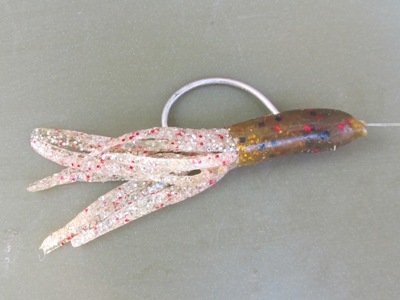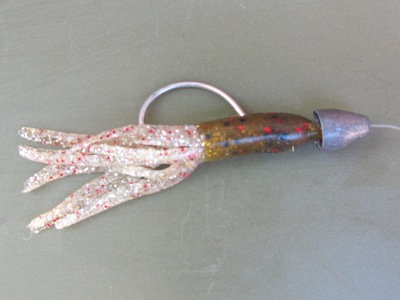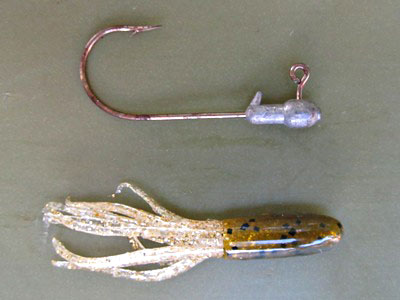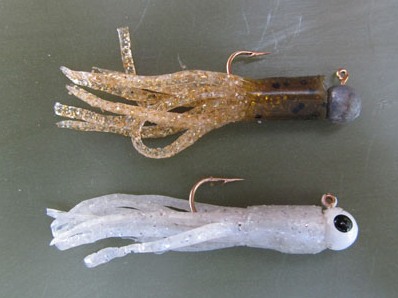Tube lures can be fished using a variety of rigs and fishing techniques. These simple soft plastic bodies can be rigged with conventional jig hooks, specialized tube jig hooks, or other rigs to cover practically any application.
For topwater fishing, tube bodies can be rigged weedless using a worm hook or modified circle hook. Tube bodies can be rigged for deeper applications, either as a Texas or Carolina rig. For vertical jigging, they can be rigged in a dropshot configuration or in tandem.
When choosing a tube lure rig, anglers should take into consideration the species of fish being targeted, their predominant prey, and known behavior. For example, tube bodies are highly effective when largemouth bass are feeding on frogs or other prey around lily pads or heavy mats of vegetation. Large tube bodies are available in a number of patterns and colors that resemble frogs. Depending on the region, these lifelike lures may also attacked by musky, pike, pickerel, or other predatory species when fished among dense vegetation.
Another application of tube lures occurs when smallmouth bass, rock bass, or other species are preying on crayfish. In these situations, anglers may choose a simple jig hook, Texas rig, dropshot, or other setup to present tubes to hungry fish. When fishing tubes in these situations, color, size, and retrieval may be critical factors for success.
Although tube bodies are popular for catching bass, their popularity is even greater among anglers that target crappie and other panfish. The wide range of rigging choices associated with tube bodies is a key reason that so many crappie anglers rely on them.
For catching sunfish, tiny tube bodies are available. These micro lures are be rigged on jig inserts and casted or jigged using ultralight gear. They can also be added on baited hooks to provide color and movement.
The unweighted weedless tube rig has several advantages. It is one of the few lures that can be retrieved successfully across dense vegetation. Its action is variable, depending on equipment and angler skill. In some situations it is most effective if retrieved slowly across the surface. Another technique is to cast and then quickly pop the rod so that the tube splashes and appears to struggle across the surface. Unweighted tube bodies do not cast well and their limited effective distances can be a problem in some situations.
The Texas rigged tube body can be very effective. Like other soft plastics, they often work best when allowed to creep over the bottom with little action. This seemingly uneventful movement closely resembles the behavior of natural prey such as crawfish or other bottom dwellers. Larger tubes can easily be Texas rigged with standard worm hooks. Small tubes can also be rigged with this configuration, although hook choices can present a challenge. When rigged correctly, Texas rigged tube lures are an extremely snag-resistant design and can be fished where most other lures would be ineffective.
Jig hook inserts are the most popular choice for rigging soft plastic tube bodies. These specially made jig hooks are made to fit inside tube bodies. Tube jig hooks come in a variety of sizes to match specific length bodies. Some models feature weedless designs. Insert type jig hooks tend to be lighter than traditional ball jig designs, which can limit their usefulness in deep water or fast moving currents. When a heavier jig is required, some anglers choose to use a barbed ball type jig hook. Tube bodies can be rigged on these type hooks by cutting off the tip of the body and sliding the tube upward onto the jig.
Choosing a quality tube body can make a big difference in fishing success. An effective tube body will have supple tentacles that move with a lifelike, pulsing motion, especially when jigged slowly. Cheaper versions may lack this essential action. Tube bodies are also available in scented versions, which are popular with anglers. Scented tubes can give anglers a critical advantage in murky water or when targeting species that rely heavily on taste.



